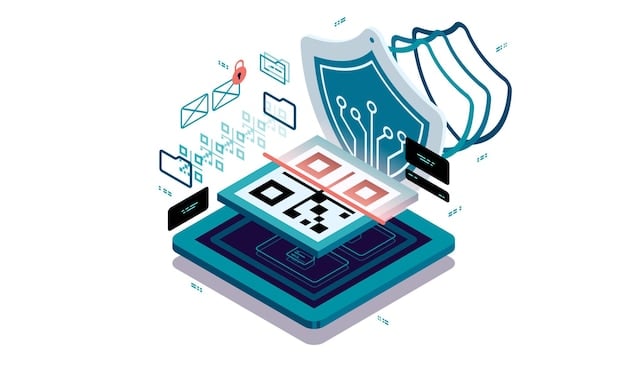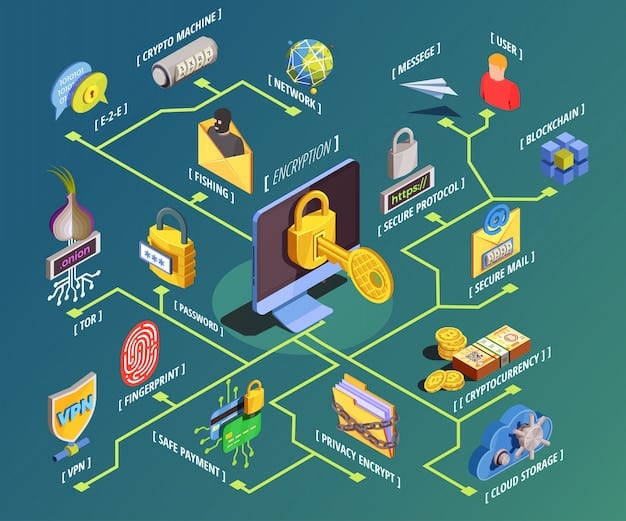The Role of 3D Secure 2.0 in US E-commerce: Boosting Payment Security

The Role of 3D Secure 2.0: Enhancing Payment Security and Reducing Fraud in US E-commerce is crucial for safeguarding online transactions by adding an extra layer of authentication, thereby minimizing fraudulent activities and building consumer trust.
In today’s digital age, e-commerce has become an integral part of the US economy. However, with the rise of online transactions, payment security and fraud prevention have emerged as critical concerns. That’s where The Role of 3D Secure 2.0: Enhancing Payment Security and Reducing Fraud in US E-commerce comes into play.
This enhanced authentication protocol is designed to protect both merchants and consumers from fraudulent activities, ensuring safer and more secure online payments. Dive in as we explore how 3D Secure 2.0 revolutionizes e-commerce security in the US.
Understanding 3D Secure 2.0 and Its Importance
3D Secure 2.0 represents the latest evolution in payment authentication protocols, designed to reduce fraud and enhance security for online transactions. This technology offers a significant improvement over its predecessor by providing a more seamless and secure payment experience.
What is 3D Secure 2.0?
3D Secure 2.0 is an authentication protocol that adds an extra layer of security to online credit and debit card transactions. It works by verifying the cardholder’s identity in real-time during the purchase process, reducing the risk of fraudulent activities. Developed by EMVCo, this protocol is widely supported by major card networks such as Visa, Mastercard, and American Express.
Why is it Important for US E-commerce?
In the US e-commerce landscape, The Role of 3D Secure 2.0 is vital due to the increasing sophistication of online fraud. By implementing 3D Secure 2.0, businesses can:
- Reduce chargebacks and associated costs.
- Enhance customer trust and loyalty.
- Comply with regulatory requirements.
- Improve the overall payment experience.

Implementing 3D Secure 2.0 not only protects businesses from financial losses but also fosters a safer online shopping environment for consumers. This added security layer is crucial for maintaining the integrity and growth of the e-commerce industry in the US.
Key Benefits of Implementing 3D Secure 2.0
Implementing 3D Secure 2.0 offers a range of benefits that can significantly enhance payment security and reduce fraud in US e-commerce. By upgrading from older security protocols, businesses can improve their fraud prevention measures and customer experience.
Enhanced Security
One of the primary benefits of 3D Secure 2.0 is its enhanced security features. The protocol uses advanced risk-based authentication, analyzing various data points to verify the cardholder’s identity. This includes device information, transaction history, and location data, providing a more accurate assessment of the transaction’s legitimacy. By leveraging these advanced techniques, 3D Secure 2.0 effectively minimizes fraudulent activities and protects businesses from financial losses.
Improved Customer Experience
Unlike its predecessor, 3D Secure 2.0 is designed to offer a more seamless and user-friendly experience. The protocol supports biometric authentication methods, such as fingerprint scanning and facial recognition, allowing customers to quickly and securely verify their identity. This streamlined process reduces friction during the checkout process, enhancing the overall shopping experience.
- Faster checkout times.
- Reduced cart abandonment rates.
- Increased customer satisfaction.
These improvements make 3D Secure 2.0 a valuable asset for businesses looking to provide a secure and convenient payment experience.
Fraud Reduction
The role of The Role of 3D Secure 2.0: Enhancing Payment Security and Reducing Fraud in US E-commerce is to significantly reduce fraud rates by adding an extra layer of authentication to online transactions. This feature helps to verify the cardholder’s identity in real-time, preventing unauthorized purchases and reducing the risk of chargebacks. By implementing 3D Secure 2.0, businesses can minimize financial losses and protect their reputation.
The reduced fraud rates not only benefit businesses but also contribute to a safer online shopping environment for consumers. This added security layer provides peace of mind and encourages customers to make more online purchases.
How 3D Secure 2.0 Works
3D Secure 2.0 operates through a sophisticated authentication process that integrates seamlessly into the online payment workflow. Understanding how this protocol works can help businesses appreciate its effectiveness in enhancing payment security.
The Authentication Process
When a customer initiates an online transaction, the merchant’s payment gateway sends a request to the card issuer to authenticate the cardholder. The issuer then analyzes various data points, such as device information, transaction history, and location data, to assess the risk level of the transaction.
Risk-Based Authentication
If the transaction is deemed low-risk, the cardholder may not be required to provide additional authentication. This is known as frictionless authentication, which provides a seamless payment experience. However, if the transaction is flagged as high-risk, the cardholder will be prompted to provide additional verification, such as a one-time password (OTP) sent via SMS or email, or biometric authentication.
Here’s a breakdown of the key steps:
- Transaction initiation
- Authentication request
- Risk assessment
- Frictionless or challenge authentication
- Transaction authorization

By using risk-based authentication, 3D Secure 2.0 balances security with convenience, ensuring that only suspicious transactions are subject to additional verification. This approach minimizes disruption to the payment process while effectively preventing fraud.
Implementing 3D Secure 2.0 in Your E-commerce Business
Implementing 3D Secure 2.0 in your e-commerce business involves careful planning and integration with your existing payment systems. This process ensures that your business can effectively leverage the security benefits of the protocol.
Integration with Payment Gateways
The first step in implementing 3D Secure 2.0 is to ensure that your payment gateway supports the protocol. Most leading payment gateways offer built-in support for 3D Secure 2.0, making the integration process relatively straightforward. You may need to update your payment gateway software or contact your provider to enable the feature.
Testing and Optimization
Once you have integrated 3D Secure 2.0 with your payment gateway, it’s essential to conduct thorough testing to ensure that the system is working correctly. This includes testing both frictionless and challenge authentication flows to verify that customers can complete transactions smoothly and securely. Optimizing your implementation based on the test results can help to fine-tune the system and improve the overall payment experience.
Best Practices include:
- Regularly update your payment gateway software.
- Monitor transaction data for fraud patterns.
- Provide clear instructions to customers during authentication.
By following these steps, businesses can successfully implement 3D Secure 2.0 and enhance payment security.
The Future of Payment Security in US E-commerce
Payment security is an ever-evolving landscape, and The Role of The Role of 3D Secure 2.0: Enhancing Payment Security and Reducing Fraud in US E-commerce is just one piece of the puzzle. As technology advances, so do the methods used by fraudsters. Staying ahead requires continuous innovation and adaptation.
Emerging Technologies
Biometric authentication is becoming increasingly popular. Technologies such as fingerprint scanning, facial recognition, and voice authentication offer a more secure and user-friendly alternative to traditional passwords and PINs. These methods are difficult to replicate, making them an effective tool for preventing fraud. Artificial intelligence (AI) and machine learning (ML) are also playing a significant role in payment security. These technologies can analyze vast amounts of transaction data to identify patterns and anomalies that may indicate fraudulent activity.
Staying Ahead of Fraudsters
To stay ahead of fraudsters, businesses need to adopt a proactive approach to payment security. This includes:
- Regularly updating security protocols.
- Implementing multi-factor authentication.
- Monitoring transactions for suspicious activity.
By staying informed about the latest security threats and implementing robust fraud prevention measures, businesses can protect themselves and their customers from financial losses. The future of payment security in US e-commerce depends on the ability to adapt and innovate in response to ever-evolving threats.
| Key Point | Brief Description |
|---|---|
| 🛡️ Enhanced Security | Advanced risk-based authentication minimizes fraud. |
| ✅ Improved Experience | Streamlined authentication with biometric options. |
| 📉 Fraud Reduction | Real-time verification prevents unauthorized purchases. |
| 🚀 Future-Proof Payments | Adapt to emerging tech like AI for proactive security. |
Frequently Asked Questions
The primary goal is to enhance online transaction security and reduce fraud in the US e-commerce sector by adding an extra layer of authentication, ensuring safer payments for both merchants and consumers.
3D Secure 2.0 offers a more seamless experience by supporting biometric authentication and risk-based analysis, reducing the need for additional verification steps for low-risk transactions.
It helps prevent unauthorized transactions by verifying the cardholder’s identity in real-time, reducing chargebacks and financial losses associated with fraudulent activities in e-commerce.
Best practices include regularly updating payment gateway software, monitoring transaction data for fraud patterns, and providing clear instructions to customers during the authentication process to ensure smooth transactions.
Businesses can stay ahead by adopting a proactive approach, regularly updating security protocols, implementing multi-factor authentication, and monitoring transactions for suspicious activities using AI and machine learning technologies.
Conclusion
In conclusion, The Role of 3D Secure 2.0: Enhancing Payment Security and Reducing Fraud in US E-commerce is more critical than ever. By implementing this advanced authentication protocol, businesses can protect themselves and their customers from the growing threat of online fraud.
As technology continues to evolve, staying informed and adapting to new security measures will be essential for maintaining a safe and secure e-commerce environment. Embrace 3D Secure 2.0 to safeguard your business and build trust with your customers in the US market.





